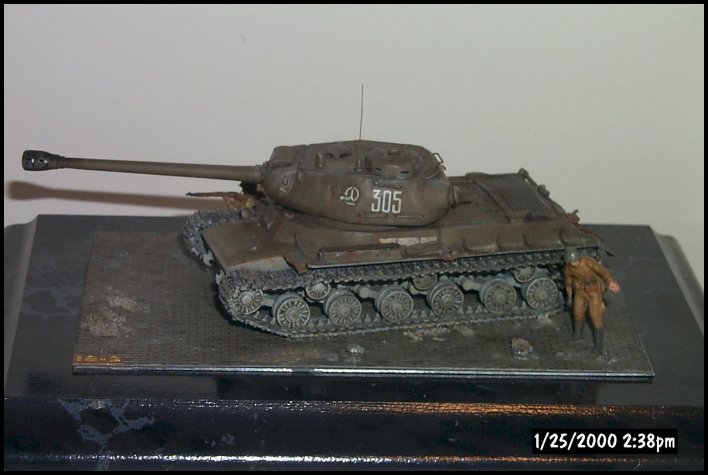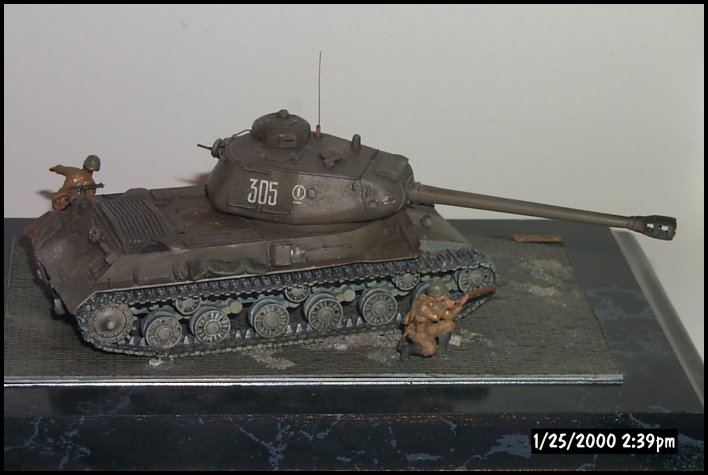

Modelling the PST IS-2 Stalin Tank
Stephen Brezinski

PST
out of the nation of Belarus is relatively new to the western market compared to Airfix and Monogram but in the small-scale armor scene it has come on strong. In the last year, it has grown to over seven kits based on the Soviet WW2 Joseph Stalin and a dozen on the KV series of tanks. (Stalin tanks were formerly known as JS in the West though now generally referred to as IS, but I won’t go into why here!) I have a fascination with the Great Patriotic War (a.k.a. WW2 Eastern Front depending where you are from) so build mostly German or Soviet. This past summer I purchased my first PST kits and PART etched brass detail set from Australia’s NKR Models website and started my collection with the IS-2 (1943).This vehicle was first introduced in 1944 as a Soviet breakthrough tank; not to fight the heavy German Panther and Tigers according to my references (listed below). The IS-2 was in the same weight range as the Panther but was smaller, heavily armored and packed a powerful 122-mm gun. This AFV was a fearful bunkerbuster and street fighter and was capable of taking out a Panther or Tiger if it met one. The kit description states 3385 produced. Its evolution began with the IS-1 featuring an 85-mm gun later featured on the T-34-85. The remaining IS-1’s were later refitted with the 122-mm gun. Both the IS-1 and IS-2 (1943) had a stepped bow with a driver’s visor. The IS-2 (1944) featured a new hull bow with a continuously sloping glacis for better armor protection.
The Model
The kit is comprised of well over 100 pieces of injection molded gray styrene on four sprues; including a sprue of styrene link & length tracks which are among the best tracks I have ever seen in the scale. The kit includes a number of parts in common with its brother IS-1, ISU, and IS-2 (1944) kits such as wheels and tracks. Some of the parts, like two of the three gun mantlets included, go only with one of the other kit variants and are unused for the parts box. Several people have told me that they got both the IS-2 (1943) and the IS-2 (1944) hulls in the kit they bought, though I just received the 1943 hull in my IS-1 and IS-2 (1943) boxes.
The styrene is a bit softer than what I am used to with Revell and Italeri kits so be careful with the sanding. The parts were crisply molded with little flash. I did not measure to confirm a 1/72 scale, but when finished it looks right.
Construction
Fit of the parts was overall good but not great. The wheels are a little touchy to put together. They must be carefully cut from the sprue to prevent damage. I did not like the way they mated together and prefer pins on the chassis that the whole wheels slip on like other makers like Hasegawa uses. Strength in the wheels is not too critical as with the styrene track links little stress is placed on the wheels like with rubber-band tracks. The torsion bar suspension is molded into the chassis sides. The joints between the hull (parts A1 & F1) and turret top and bottoms (F3 & F4) needed some filling and sanding. To give the hull and turret some roughcast texture (and the real tank’s castings were very roughly textured) I coated them with slow drying liquid cement and brushed with an old stiff toothbrush. The kit’s commander’s copula had no vision ports molded in. These ports I melted in with a small flat screwdriver tip after carefully marking their locations around the copula. You will want to drill in the periscope vision holes as well.
I wished to build my IS-2 as one in combat so I built it without the exterior fuel tanks and a little battle damage and weathering, but not enough damage and weathering to distract from the model. In photos I’ve noted that it was common for the front fenders to be gone. I suspect that they were damaged during combat or while maneuvering through the countryside or city and were eventually cut off back to one of the fender braces. The brass fender braces included with the PART set came in handy here. With cutting off the kit fenders, the first set of braces were just eliminated and the second set back replaced by the brass ones. Forward of the remaining braces short strips of aluminum sheet was added to simulate remaining fender.
Glancing AT round hits were simulated by gouging the styrene in several locations on the glacis and turret with a blunt graphite pencil tip. The pencil is ideal as it can be sharpened or dulled to get the right diameter, the pencil wood may burn but the graphite won’t, and it is hot enough to melt the plastic and form realistic ridges on the side like a glancing blow would do.

Grab handles for tank riders were simulated with brass wire bent over a homemade jig. The antenna on the roof of the turret is a plastic paintbrush bristle: flexible and remains straight under abuse. The rear turret machine gun barrel was also replaced with brass rod. This is an early IS-2, so no gun rest on the rear deck was installed. I added little stowage, just a rolled tarp on the right rear fender.
The PART brass detail set is superb. Like Aber brass, there are more parts than you may want to use. The set consists of over 120 fine and crisply etched parts. Major parts include a set of four fuel tanks with mounting brackets, new storage boxes, grad handles (flat though), engine screens, turret hatch, and many small (and I mean SMALL) fittings. The most complex brass project was the 30 piece engine vent louvers to replace those on the engine deck. I skipped doing the louvers… I just don’t think I’m skilled or obsessive/compulsive enough to do them well! The kit’s engine deck was done well enough anyway.
Painting & Decals
Soviet tanks were officially supposed to be dark green but according to experts, and common sense of war production & weathering, I understand they were actually dark green to various shades of olive. I opted for a brown olive shade in Poly-S acrylic purely because most all my other Soviet vehicles are in a more forest green. Prior to the primary color I sprayed a coat of light gray primer to prime the brass and reveal any surface defects. Following the olive coat I glossed the entire model in acrylic floor wax, which provided a good base for the decals, and helped evenly distribute the turp & oil wash after the decals. Yes, I like good old-fashioned turpentine wash, and its smell. After decals were applied the lower vehicle body and suspension was spayed with a gray-tan acrylic paint roaddust. The model was highlighted with white oil paint and then dullcoated with Poly-Scale acrylic. The white artist-oil can make a good feathered-edge, can be wiped off if you make a mistake, and is translucent in light coats.
The decals were in particular a pleasant surprise. They come on an ultra-thin film that almost disappears on the model with just a little setting solution. Please slide them off the paper carefully directly onto the model or they curl up like a jellyroll. Amazingly I was able to unroll the decal with what would be considered rough treatment and it set down perfect. The display base is model-RR brick pattern to represent a cobble road glued down to commercial plaque. The two figures are Revell, used to better give a feeling of scale to the model.
Overall I highly recommend this and the other PST kits. The subject is certainly is a wonderful addition to small (Braille) scale modeling.
Resources
| Main | What's New | Articles | Reviews | Gallery | Think Tank | Contests |